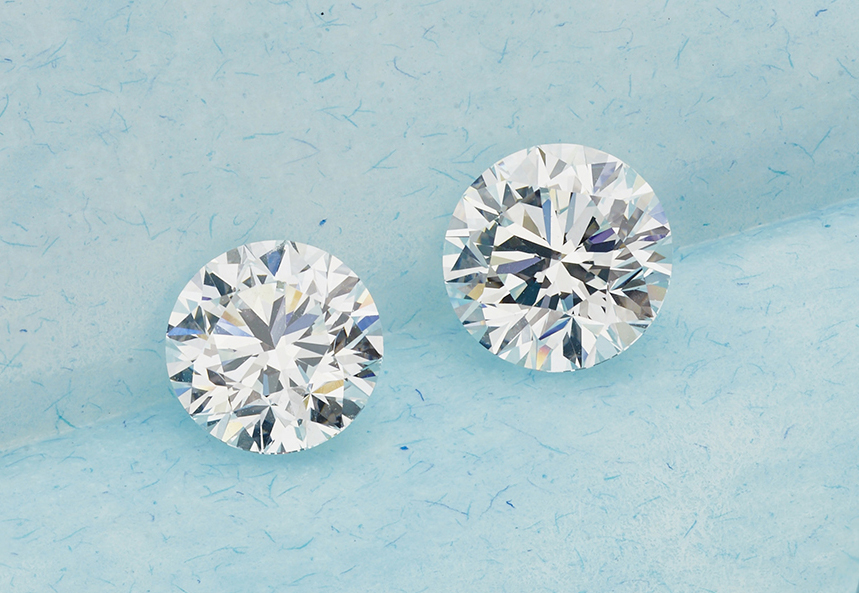We compared a 1-carat vs 1.20-carat diamond to learn the size difference and cost of each option.
A noticeable size difference exists between a 1-carat diamond and a 1.20-carat size diamond.
However, a noticeable difference appears between each diamond when viewed side-by-side.
Please note that we use the correct spelling of 1 Carat diamond, and not 1 Carret diamond or 1 Carrot diamond – both inaccurate spellings. Surprisingly, misspellings appear frequently across the web.
Light performance and brilliance
Provided both diamond sizes feature the same cut grade, colour clarity, polish and symmetry, expect very little difference in light performance, brilliance and scintillation between each size. At the same time, specifications such as proportions, depth percentage and other factors will be in proportion.

A comparison between a 1-carat 6.4mm diamond (left) alongside a 1.20-carat diamond 6.75mm (right)
How big are 1-carat diamonds compared to 1.2ct diamonds?
One-carat diamonds, typically measure between 6.3 – 6.5mm in diameter. By comparison, a 1.20 carat diamond measures around 6.75mm in diameter.
Nevertheless, this subtle difference makes a visual difference as seen in our comparison.
1-Carat vs 1.20-Carat sizes across different diamond shapes
The following chart provides a guide to 1-carat and 1.20-carat measurements for popular diamond shapes.
| Diamond Shape | Approximate Measurements for 1-carat Diamond (mm) | Approximate Measurements for 1.20-carat Diamond (mm) |
|---|---|---|
| Round Brilliant | 6.5 | 6.9 |
| Princess Cut | 5.5 x 5.5 | 5.7 x 5.7 |
| Emerald Cut | 7.0 x 5.0 | 7.2 x 5.2 |
| Asscher Cut | 6.0 x 6.0 | 6.2 x 6.2 |
| Cushion Cut | 6.0 x 6.0 | 6.2 x 6.2 |
| Radiant Cut | 6.2 x 5.0 | 6.4 x 5.2 |
| Oval Cut | 8.0 x 5.5 | 8.2 x 5.7 |
| Marquise Cut | 10.0 x 5.0 | 10.2 x 5.2 |
| Pear Cut | 8.0 x 5.0 | 8.2 x 5.2 |
| Heart Cut | 6.5 x 6.5 | 6.7 x 6.7 |
1ct vs 1.2ct diamonds and choosing a suitable setting
Your chosen diamond shape will influence your ring design and corresponding ring setting. For example, a heart-shaped diamond requires a bezel setting or three claw design. Round diamonds benefit from a greater choice of ring styles in precious metals including White Gold, Yellow Gold, Rose Gold and Platinum.
For round brilliant-cut diamonds, the classic “Tiffany-style engagement ring” makes a wonderful choice. Many describe the iconic style as simple and understated, classic and contemporary.
Four claws provide a squared effect, whereas six claws offer more security and give a rounded appearance to the ring.
Browse our selection of solitaire styles, for more inspiration on ring styles.
Comparing the cost of 1-Carat vs 1.20-Carat diamonds
Both 1-carat and 1.20-carat diamonds are priced at the exact same price per carat regardless of their colour or clarity. For guidance, we apply an increase of 20% over the price of a one-carat diamond.
Having said this, prices vary. For example, some diamond sellers may apply a premium to the price of a diamond if a scarcity exists based on the carat weight, colour and clarity of a particular diamond.
1 carat vs 1.20 carat – which do most people choose?
1ct diamonds remain the most popular of both sizes. But, different reasons exist why a buyer might choose the larger stone size. For example, the price given might suit their chosen budget. Or, perhaps the number 120 has some personal significance.
Another reason could be a desire to upgrade beyond 1-carat.
One of our past clients had already been engaged many years earlier. They loved the size of their 1-carat stone but chose the larger size to distance themselves from the same carat weight as before.
At the same time, other clients in the past upgraded an existing diamond to “grow their diamond” over time. We routinely remake engagement rings to accommodate larger stone sizes. We do this by replacing the setting, in the same style—made larger for the new diamond.
Natural vs lab-grown diamonds in 1ct and 1.2ct sizes
Few buyers realise that both diamond sizes can be sourced in natural and ethical lab-grown diamond options. The distinct difference between natural and lab-grown lies in the overall cost.
With lab diamonds coming in around 50-60% lower in cost, laboratory-grown diamonds provide a cost-effective way to buy a 1 carat or 1.2 carat diamond. Furthermore, most lab-diamonds are available as high quality diamonds in the best colour and clarity grades.
Regardless, lab-grown diamonds provide an enticing option—identical in every way possible to a natural diamond. However, don’t expect the value to climb. In essence, lab-grown diamonds lack the rarity of a natural mined diamond and their value will always reflect this regardless of carat size.
About Mark Johnson
My name is Mark and I'm founder at Serendipity Diamonds. I have 30 years or experience in polished diamonds and jewellery. Today, I work with an expert team in our Isle of Wight jewellery showroom located in Ryde. Most of my work involves helping clients in our showroom, working on our two websites and photographing jewellery commissions.



